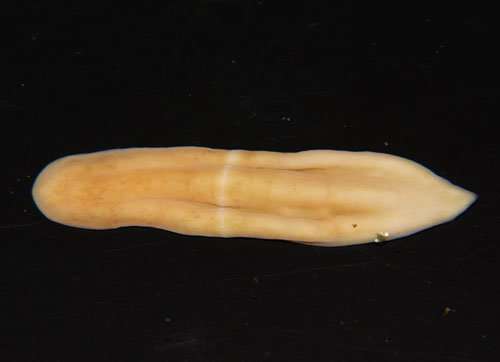Mysterious new seafloor species sheds light on early animal evolution

Japanese researchers have discovered a new species of the enigmatic marine worm Xenoturbella, which they have named Xenoturbella japonica, as reported in a new study published in BMC Evolutionary Biology.
Xenoturbella lacks certain features common among more complex animals, such as a centralized nervous system, kidneys, and an anus (i.e., its digestive system has only one opening). Thus, these primitive worms are important for understanding the origins of these structures. The classification of Xenoturbella in the tree of life has been controversial, but it is generally regarded as a basal member or sister group of the Bilateria, a group that includes most complex animals.
The researchers, centered at the University of Tsukuba, described two specimens of X. japonica dredged from the seafloor of the western Pacific: a female about 5 cm in length, and a juvenile about 1 cm in length. Both specimens are pale orange in color, with an oval-shaped mouth and a glandular network on the ventral (bottom) surface.
MicroCT scanning, a method not previously applied to Xenoturbella, revealed the specimens' internal structures, and a new feature not visible using conventional methods: the frontal pore.
"We also extracted DNA and sequenced the mitochondrial genome and partial Histone H3 gene sequences," co-author Hideyuki Miyazawa explains. "Molecular phylogenetic analysis confirmed that X. japonica is distinct from previously described species of Xenoturbella."
DNA contamination from several species of bivalve was also detected, which indicates that, like other species of Xenoturbella, X. japonica likely feeds on marine bivalves.
"Species within this genus have previously been divided into 'shallow' and 'deep' subgroups, and our results place X. japonica in the 'shallow' subgroup," lead author Hiroaki Nakano says. "Interestingly, X. japonica shares features with both subgroups, however. Thus, features of this species may be ancestral for this genus, and this new species may be particularly important for unraveling the ancestry of Xenoturbella and the early history of the Bilateria."
Research on Xenoturbella has been limited by the inaccessibility of specimens in their seafloor habitats hundreds or thousands of meters below the surface. This new discovery may offer a solution. As co-author Hisanori Kohtsuka explains, "because one habitat where X. japonica was found is easily accessible from a marine station, this new species promises to be valuable for future research on bilaterian and deuterostome evolution."
More information: Hiroaki Nakano et al, A new species of Xenoturbella from the western Pacific Ocean and the evolution of Xenoturbella, BMC Evolutionary Biology (2017). DOI: 10.1186/s12862-017-1080-2
Journal information: BMC Evolutionary Biology
Provided by University of Tsukuba




















